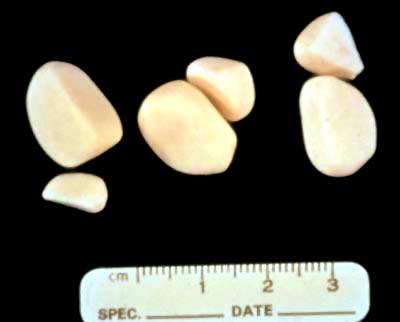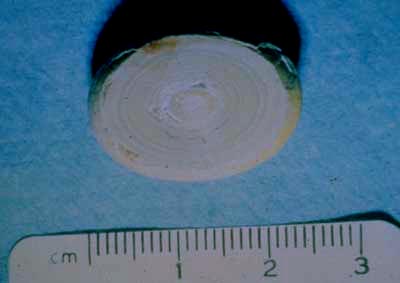Urolithiasis
Synonym(s): Bladder stones, Cystic calculi, Ureteral calculi, Nephroliths
Introduction
- Urolithiasis refers to the presence of stones anywhere in the urinary tract.
- Most canine uroliths are found in the lower urinary tract.
- Most common types: struvite (magnesium ammonium phosphate), calcium oxalate, cystine and ammonium urate.
- Rarer types: calcium phosphate, silica, carbonate, xanthine and drugs or their metabolites.
- Incidence estimated at 0.3-2.8%.
- Cause: (and therefore treatment) depends on type of urolith; usually due to underlying inherited, congenital or acquired metabolic disorder or infection.
- Signs: usually of lower urinary tract disease (may be none).
- Prognosis: many uroliths recur unless underlying cause is corrected, eg infection.
Print off the owner factsheet on Bladder and kidney stones Bladder and kidney stones to give to your client.
Use the interactive tools from ROYAL CANIN® UK ![]()
![]() to explain dog anatomy and disease conditions to your client. Visit ROYAL CANIN Natom Explorer to find out more.
to explain dog anatomy and disease conditions to your client. Visit ROYAL CANIN Natom Explorer to find out more.
Presenting signs
- Dysuria.
- Pollakiuria.
- Hematuria.
- In association with urinary tract infection.
- Urinary tract obstruction (upper or lower); usually urethral.
Acute presentation
- Urinary tract obstruction.
- Post-renal acute kidney injury Kidney: acute kidney injury (AKI).
Age predisposition
- Struvite: adult.
- Calcium oxalate: adults.
- Cystine: 3-5 years.
- Urate: 1.5-7 years.
- Struvite: puppies.
Breed/Species predisposition
- Dalmation Dalmatian - urate
 .
. - Miniature Schnauzer Schnauzer: miniature - calcium oxalate, struvite, urate.
- Yorkshire Terrier Yorkshire Terrier - calcium oxalate, urate.
- Dachshund Dachshund - cystine, struvite.
- Bulldogs Bulldog - cystine, urate.
- Newfoundland Newfoundland - cystine.
- Mastiff Mastiff - cystine.
- Lhasa Apso Lhasa Apso - calcium oxalate.
- Bichon Frise Bichon Frise - calcium oxalate, struvite.
- Shih Tzu Shih Tzu - calcium oxalate, struvite, urate.
- Miniature Poodle Poodle: miniature - calcium oxalate.
- Pug Pug – struvite.
Cost considerations
- Emergency therapy for acute urinary obstruction and kidney injury.
- Surgery.
- Tendency to recur.
- Quantitative mineral analysis.
- Radiography.
- Dietary modification.
Special risks
- Acute post-kidney injury due to obstruction Kidney: acute kidney injury (AKI).
Pathogenesis
Etiology
- Supersaturation of urine with crystalloid → crystal nidus (nucleus) formation.
Predisposing factors
General
- Urine pH.
- Diet.
- Metabolic acidosis or alkalosis Acid base imbalance.
- Medication.
- Anatomical abnormalities.
- Lifestyle.
- Gender.
- Sedentary lifestyle.
- Genetic mutation.
Specific
- Urinary tract infection Cystitis (struvite) with urease producing bacteria (eg Staphylococcus and Proteus).
- Portosystemic shunt Congenital portosystemic shunt (CPSS) (urate).
- Hypercalcemia (calcium oxalate).
- Breed.
Pathophysiology
- Inherited, congenital or acquired predisposing condition; depends on nature of urolith.
- Supersaturation of urine with calculogenic crystalloids.
Struvite
- Approximately 50% of uroliths






 .
. - Oversaturation of urine with magnesium ammonium phosphate.
- Urinary tract infection with urease-synthesizing bacteria (eg Staphylococci, Proteus, Enterobacter, Klebsiella, etc) → hydrolysis of urea → ammonia and carbon dioxide → alkaline urine.
- More common in females as higher risk for urinary tract infection.
- Other factors: alkaline urine, high protein diet, genetic predisposition.
Calcium oxalate
- Approximately 30% of uroliths


 .
. - Hypercalciuria.
- Causes of hypercalciuria:
- Intestinal hyperabsorption of calcium.
- Decreased renal absorption.
- Hypercalcemia Hypercalcemia: overview , eg primary hyperparathyroidism, paraneoplastic.
- Hyperoxaluria – primary hyperoxaluria in the Coton de Tulear Coton de Tulear.
Cystine
- Approximately 1% of uroliths


 .
. - Metabolic defect → increased urinary excretion of cystine, lysine, arginine and ornithine.
- Acidic urine → precipitation of cystine.
- Association with entire males in some breeds, resolves with neutering.
Urate
- Approximately 8% of uroliths


 .
. - Dalmatian → defect in hepatic uric acid metabolism → increased urinary urate excretion.
- Defect in hepatic uric acid metabolism can also be seen in other breeds, most commonly in English Bulldogs and Black Russian Terriers Black Russian Terrier.
- Other causes: hepatic dysfunction or portal vessel anomalies (portosystemic shunts) → decreased urate metabolism.
Timecourse
- Uroliths may not be detected until dog is middle-aged.
Diagnosis
Subscribe To View
This article is available to subscribers.
Try a free trial today or contact us for more information.
Treatment
Subscribe To View
This article is available to subscribers.
Try a free trial today or contact us for more information.
Prevention
Subscribe To View
This article is available to subscribers.
Try a free trial today or contact us for more information.
Outcomes
Subscribe To View
This article is available to subscribers.
Try a free trial today or contact us for more information.
Further Reading
Publications
Refereed papers
- Recent references from PubMed and VetMedResource.
- Lulich J P, Berent A C, Adams L G et al (2016) ACVIM Small Animal Consensus Recommendations on the Treatment and Prevention of Uroliths in Dogs and Cats. J Vet Intern Med 30 (5), 1564-1574 PubMed DOI: 10.1111/jvim.14559.
- Hoppe A & Denneberg T (2001) Cystinuria in the dog - clinical studies during 14 years of medical treatment. J Vet Intern Med 15 (4), 361-367 PubMed.
- Caywood D D & Osborne C A (1986) Surgical removal of canine uroliths. Vet Clin North Am Small Anim Pract 16 (2), 389-407 PubMed.
- Osborne C A & Polzin D J (1986) Non-surgical management of canine obstructive urolithopathy. Vet Clin North Am Small Anim Pract 16 (2), 333-347 PubMed.
- Osborne C A, Klausner J S, Krawiec D R et al (1981) Canine struvite urolithiasis - problems and their dissolution. JAVMA 179 (3), 239-244 PubMed.
Other sources of information
- Osborne C A, Lulich J P, Barges J W (eds) (1999)The Rocket Science of Canine Urolithiasis. The Vet Clin North Am Small Anim Pract 29(1), 1-306.
- Davies M (1996) Management of Canine and Feline Urolithiasis. In: BSAVA Manual of Canine and Feline Nephrology and Urology. Bainbridge J & Elliot J (eds). Chapter 17. pp 209.
- Ling G V & Sorenson J L (1995) Management and prevention of urate uroliths. In: Current Veterinary Therapy XII. Kirk (ed) W B Saunders, Philadelphia. pp 985-998.
- Lulich J P & Osbourne C A (1995) Canine calcium oxalateuroliths. In: Current Veterinary Therapy XII. Kirk (ed) W B Saunders, Philadelphia. pp 992-996.
- Hope A (1994) Canine Lower Urinary Tract Disease. In: Waltham Book of Clinical Nutrition of the dog and cat. Chapter 19. pp 335. (Very useful overview.)
- Osborne C A, Lulich J P, Bartges J W, Thumchai R, Felice L J, Unger L K, Koehler L A, Bird K A & Swanson L (1994) Canine urolithiasis - diagnosis, treatment and prevention. In: Renal Disease in Small Animal Practice. Trenton, NJ: Veterinary Learning Systems. pp 133-150. ISBN 1 884254 18 7 (Useful tables and flow diagrams).